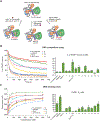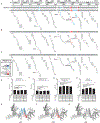Novel modifications of PARP inhibitor veliparib increase PARP1 binding to DNA breaks
- PMID: 38372302
- PMCID: PMC11070930
- DOI: 10.1042/BCJ20230406
Novel modifications of PARP inhibitor veliparib increase PARP1 binding to DNA breaks
Abstract
Catalytic poly(ADP-ribose) production by PARP1 is allosterically activated through interaction with DNA breaks, and PARP inhibitor compounds have the potential to influence PARP1 allostery in addition to preventing catalytic activity. Using the benzimidazole-4-carboxamide pharmacophore present in the first generation PARP1 inhibitor veliparib, a series of 11 derivatives was designed, synthesized, and evaluated as allosteric PARP1 inhibitors, with the premise that bulky substituents would engage the regulatory helical domain (HD) and thereby promote PARP1 retention on DNA breaks. We found that core scaffold modifications could indeed increase PARP1 affinity for DNA; however, the bulk of the modification alone was insufficient to trigger PARP1 allosteric retention on DNA breaks. Rather, compounds eliciting PARP1 retention on DNA breaks were found to be rigidly held in a position that interferes with a specific region of the HD domain, a region that is not targeted by current clinical PARP inhibitors. Collectively, these compounds highlight a unique way to trigger PARP1 retention on DNA breaks and open a path to unveil the pharmacological benefits of such inhibitors with novel properties.
Keywords: HXMS; PARP; allosteric regulation; crystallography; veliparib analogs.
© 2024 The Author(s). Published by Portland Press Limited on behalf of the Biochemical Society.
Conflict of interest statement
Competing interests
B.E.B., J.M.P., and T.T.T. are co-founders of Hysplex, Inc. with interests in PARP inhibitor development, B.E.B is on the scientific advisory board of Denovicon Therapeutics.
Figures






Similar articles
-
Captured snapshots of PARP1 in the active state reveal the mechanics of PARP1 allostery.Mol Cell. 2022 Aug 18;82(16):2939-2951.e5. doi: 10.1016/j.molcel.2022.06.011. Epub 2022 Jul 5. Mol Cell. 2022. PMID: 35793673 Free PMC article.
-
Mechanistic Dissection of PARP1 Trapping and the Impact on In Vivo Tolerability and Efficacy of PARP Inhibitors.Mol Cancer Res. 2015 Nov;13(11):1465-77. doi: 10.1158/1541-7786.MCR-15-0191-T. Epub 2015 Jul 27. Mol Cancer Res. 2015. PMID: 26217019
-
Enhanced killing of cancer cells by poly(ADP-ribose) polymerase inhibitors and topoisomerase I inhibitors reflects poisoning of both enzymes.J Biol Chem. 2012 Feb 3;287(6):4198-210. doi: 10.1074/jbc.M111.296475. Epub 2011 Dec 12. J Biol Chem. 2012. PMID: 22158865 Free PMC article.
-
Mitotic functions of poly(ADP-ribose) polymerases.Biochem Pharmacol. 2019 Sep;167:33-43. doi: 10.1016/j.bcp.2019.03.028. Epub 2019 Mar 22. Biochem Pharmacol. 2019. PMID: 30910692 Free PMC article. Review.
-
The complex universe of inactive PARP1.Trends Genet. 2024 Dec;40(12):1074-1085. doi: 10.1016/j.tig.2024.08.009. Epub 2024 Sep 20. Trends Genet. 2024. PMID: 39306519 Review.
Cited by
-
A PARP2 active site helix melts to permit DNA damage-induced enzymatic activation.Mol Cell. 2025 Mar 6;85(5):865-876.e4. doi: 10.1016/j.molcel.2025.01.004. Epub 2025 Jan 30. Mol Cell. 2025. PMID: 39889708
-
A PARP2-specific active site α-helix melts to permit DNA damage-induced enzymatic activation.bioRxiv [Preprint]. 2024 May 20:2024.05.20.594972. doi: 10.1101/2024.05.20.594972. bioRxiv. 2024. Update in: Mol Cell. 2025 Mar 06;85(5):865-876.e4. doi: 10.1016/j.molcel.2025.01.004. PMID: 38826291 Free PMC article. Updated. Preprint.
References
Publication types
MeSH terms
Substances
Grants and funding
LinkOut - more resources
Full Text Sources
Molecular Biology Databases
Miscellaneous

